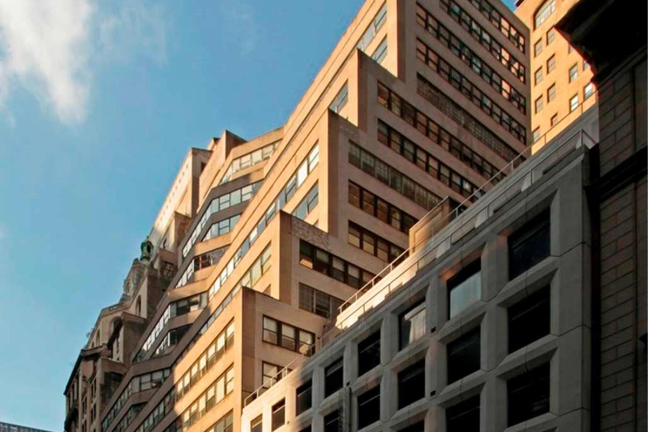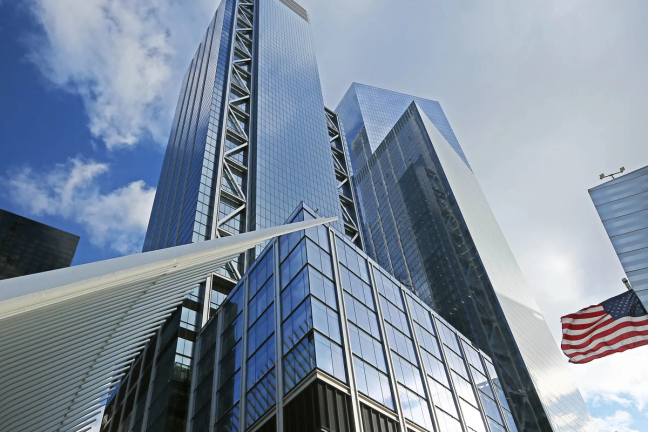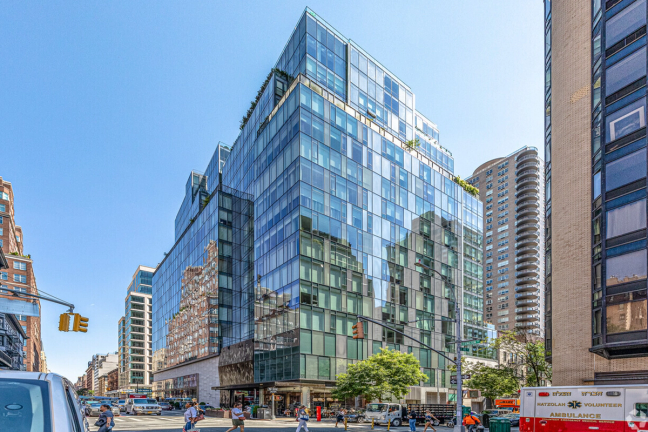New York's Real Estate Royalty
New York’s real estate dynasties aren’t all blustering Trumps. Encased in the very fabric of the looming towers that continue to spike up across Manhattan and the rest of the five boroughs are older, quasi-aristocratic clans, who have long spearheaded the unstoppable urbanisation of the city.
But the spotlight has never been forgiving for NewYork’s real estate royalty, with tales of scandal and excess, sex, drugs and family feuds à la Succession exposed on the front pages of the city’s newspapers for decades; particularly in their heyday between the 1960s and 80s, when an uncomfortable association with politicians or the mob was all too difficult to ignore.
It’s no surprise, then, that they’ve decided to turn down the decibels on their private lives. But New York’s real estate royals are still very much there, continuing to shape the character of the metropolis: the Rudins, Dursts, Milsteins, Roses, Fishers, Tishmans and Resnicks. Unlike Trump (who, for obvious reasons, they’ve done their best to disassociate with; considered a second-generation wide-boy grifter) these names barely ring a bell, but their savviness, wealth and behind-the-scenes influence have cultivated enough power to sculpt the city through its worst and best times: New York’s answer to the Silicon Valley tech gurus, Dallas oil barons or Pittsburgh steel bosses. New York’s real-estate royalty still reign supreme. With a few additions and subtractions, these are the same families that have dominated the city’s real estate for over half a century — as close to a stable ruling class as New York has enjoyed since the era of the Astors and the Rhinelanders. Though factions and alliances have existed (especially among the old guard: the Tishmans and Dursts, Tishmans and Rudins, Roses and Rudins, etc.) they are still likely to do business with one another... as well as compete for valuable real estate that now extends across fashionable Brooklyn to the developing Bronx boroughs. Gentrification pays — locations in the outer boroughs are now, on average, as much as Manhattan, at $4,500 per month. Commercial space, however, might not — at least in the foreseeable future — as experts forecast a slump.
The origins of the oldest dynasties are colourful, gilded examples of the American Dream: immigrants, mostly from Eastern Europe, some from the hard-working Yiddish communities that populated the city in the early 20th century, like Robert Tishman (of Tishman Speyer) and David Rose (of Rose Associates). Newer dynasties like the Milsteins, Macklowes and Roths bring a different energy, flourishing during the 80s Gordon Gekko era — the majority of them preferring to invest in commercial properties instead of residential, like their real estate forebears.
In 2023, this is looking like a poor investment, with a suspected fallout in the city’s non-residential sites owed to high interest rates and empty offices. Fifty percent are suspected to be unused, so there are currently talks (perhaps with a firm nudge from these influential figures, like Charles S Cohen and the long-suffering Steven Roth) around relaxing laws for commercial office sites to be transitioned into residential ones. Nobody could have predicted that in the 1980s.
And even real estate royalty aren’t immune to succession issues. Think about the Roys, from, well, the TV show Succession — and the plights of Kendall, Roman and Shiv in competition for their father’s business. New York’s real-life Roys are no different: each dynasty usually has a strong patriarch at its head, from Aby Rosen to Daniel Tishman, with the latter family, in particular, already known to be fractured through feuds that have divided them into separate camps (to the point they won’t sit near each other at the same restaurant or dinner). The Milstein brothers are also in a rift. The pressure within each family is startling — especially for those fated to inherit an empire. How do such children, born into a world of wealth, discover the same dogged pursuit of rags-to-riches success from their parents, many of whom started out with nothing? That attitude just can’t be bought, and so as these families enter their second, third and sometimes fourth generations, there is an emphasis on playing it safe with their investments to prevent empire-crumbling losses. Perhaps that’s another reason why they’re more under the radar today than they were before.
Another characteristic of the New York real estate royals is their philanthropy. It’s easy to be cynical here: the Milsteins putting $50m in a presbyterian heart hospital is written straight out of an HBO political series, where the oligarchs make a deal with the city council for... benefits (the imagination goes wild). Likewise for the Rudins, who run sustainability programmes across their portfolio; theRoses; and the Tishmans, who have actively campaigned for affordable housing. Many of these philanthropic efforts are great self-branding; a political act that might be motivated through sincerity, or to improve the stature of their family name across New York. Whatever the case, it still goes hand in hand with their continued influence on how the city looks and feels, and cements them as a powerful ruling class, giving back to their communities. Whatever their motivations, the real estate royals are a fascinating breed, vying to remain kings of the Big Apple. Each giveth, and sometimes taketh, to stay at the very top,even when the future of the real estate market is uncertain. Here’s what you need to know about the big players.
NYC Dynasties
Newer Guard
Tishman

Rockefeller Centre
With roots as far back as 1898, the family currently operate portfolios under either Tishman-Speyer, with Rob Speyer at the helm, or TISHMAN, thanks to a reported divide. Buildings include the Rockefeller Centre, MetLife Building, and CitySpire.
Rudin

Dock 72
When Louis Rudinsky bought his first building in Manhattan in 1905, the Rudin empire was born. Around 30 family members have ownership interests in the properties.
Rose

Anagram Columbus Circle
Founded by David Rosein 1925, Rose Associates was among the earliest to corner New York’s real estate market, going on to manage over 31,000 properties. Now run by Amy Rose Silverman, it is one of the market’s few female-owned businesses.
LeFrak

LeFrak City
Worth over $6bn, the LeFraks oversee one of New York’s largest real estate empires, founded by Harry LeFrak in 1901. They are best known for LeFrak City in Queens.
Milstein

Bristol Plaza
Worth over $3bn, the Milsteins are one of American real estate’s wealthiest and most influential families. Morris Milstein founded the family business in 1919.
Tisch

Loews Regency Hotel
Founded by the late brothers Preston Robert and Laurence Tisch in 1946, the dynasty is now headed by their wives Joan and Wilma, who share the family fortune with their sons. Rob Tisch is credited with coining the term ‘power breakfast’.
Durst

One World Trade Centre
The Dursts own more than 16 million square feet of real estate in New York and Philadelphia, including a stake in One World Trade Centre. Their fortune is worth an estimated $8.1bn.
Older Guard
Rosen

Paramount Hotel
German-born Aby J Rosen co-founded RFR Holding in 1991, and the company today owns a portfolio valued at over $15.5bn. Rosen is an avid art collector, owning over 800 postwar pieces, including more than 100 works by Andy Warhol.
Cohen

3 East 54th Street
Founded in the 1950s by Eddie, Mortimer, and Sherman Cohen, Cohen Brothers Realty & Construction is one of NewYork’s most prominent investors in commercial properties, largely in Class A office buildings. Today it is run by Charles S Cohen.
Silverstein

World Trade Centre
Silverstein Properties was started in 1957 by Larry Silverstein. Today it is New York City’s fifth-largest commercial landlord, most notable for the rebuilt World Trade Centre, which included a dispute with the Tishmans in 2006. Larry remains at the helm
Roth

The Lucida
Steven Roth is chairman of real estate investment trust Vornado Realty Trust, owning 20 million square feet of office and retail space. Roth is currently confronting challenges in his bid to transform the area around NYC’s Penn Station railway hub.
Macklowe

432 Park Avenue
Known for the ongoing432 Park Avenue legal disputes, Harry B Macklowe has seen himself featured regularly in the New York media for his colourful personal life, too. His buildings have courted controversy for being ‘ugly’ and structurally inept.
Ever wanted to know where the city's bigwigs do business over brunch? We've got the intel...

Become a Gentleman’s Journal Member?
Like the Gentleman’s Journal? Why not join the Clubhouse, a special kind of private club where members receive offers and experiences from hand-picked, premium brands. You will also receive invites to exclusive events, the quarterly print magazine delivered directly to your door and your own membership card.